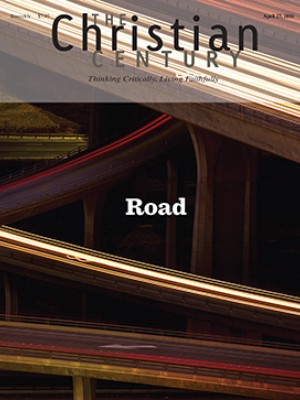May 8, Easter 7C (Acts 16:16-34; Revelation 22:12-14, 16-17, 20-21; John 17:20-26)
In the 19th century, a number of American printmakers popularized the image of the tree of life (you can see these on Google Images). Currier and Ives designed one, with each fruit of the tree labeled as one of the Christian virtues; Victorian angels with eyes upcast are standing in attendance at the tree, and in the distance is the city of God, shining like a magnificent Walt Disney castle. In another depiction, two angels are protecting the tree from a devil who is brandishing an axe. Heavenly rays, shining from above, are labeled Grace.
But the lithograph most appropriate for this Sunday was produced in 1847 by the Kellogg brothers and Horace Thayer. In the foreground are people milling about in a city, standing on The Broadway and engaged in all manner of sin, labeled drinking, extortion, usury, chambering, and wantonness. Babylon, Mother of Harlots, wearing her low-cut gown, beckons the people toward the open door to hell. Meanwhile, two Methodist preachers are trying their best to call the crowd toward the gates of the city of God, and inside these gates is the tree of life. The fruits of the tree are, as expected, labeled with the Christian virtues. Above the tree is God, represented by the classic triangular design. And on the trunk of the tree is the crucified Christ.
Read our latest issue or browse back issues.
During Eastertide we have read not the blood-and-guts passages of the book of Revelation, but rather its resurrection songs. Today’s reading concludes these songs. The baptized are wearing their white robes, entering the city by its gates and enjoying the fruits of the tree of life. (Remember that in C. S. Lewis’s The Magician’s Nephew, the witch has to climb over the wall to lurk near the tree in the center of the garden.) But the tree of the book of Revelation is not merely one of the countless archetypal trees that religions and cultures everywhere have imagined. This tree is the risen Christ, the Alpha and the Omega not only of this book but of the whole of Christian life.
Then the visionary recalls the ancient Near Eastern imagery of the monarch as the great tree, whose vibrancy ensures the health of the kingdom. For Christians, the risen Christ is the root of that monarchical tree of David, its source, its hidden foundation. Yet Christ is not only the root but also the crown of the tree of Jesse, seen from afar on the mountaintop, high above all else. Christ is the beginning and the end of the tree, of the people, of the city.
And in biblical fashion this one image, even when layered and made more complex, is not enough: if you are not a person drawn to the imagery of the tree of life, the seer also invokes Venus, the morning star promising the arrival of day, the light shining in our darkness, and that star is the risen Christ. And so the church marries this tree, this star—and our thirst is quenched by the water of life. Let’s hope that the lector reads majestically, to give us time to receive each image.
This visionary picture of Christ’s resurrection is not all this week’s readings present us with. In the first reading, the author of the “we” passages of Acts narrates an adventure that mirrors the death and resurrection of Christ. Paul, like Jesus before, performs an exorcism, replacing the power of evil with that of God in Christ. Like Jesus, Paul and Silas are arrested by the authorities and beaten. Now it is the disciples who are released from their prison of death and who preach the gospel, make disciples, and baptize. We need not wait until the end, or our end, to enter the gates of the city of God. It is here, by the power of the Spirit, available to all the baptized.
The Gospel for the day is a prayer. This praying Jesus—the Alpha, the Omega, the tree of life, the bright morning star—this risen Christ is one with God, as if a son to a father. We are called to join in the prayer, to be one with one another, to be one with the risen Christ who is one with God. So the Kellogg and Thayer print labels the roots of the tree of life with these adjectives: almighty, glorious, holy, wise.
The 50 days of celebrating the resurrection cannot obscure the explicitly Christian version of the tree. As we come around the table to share the bread and wine, we dance around not any old archetypal tree, as if in nature alone is our salvation. The seer describes the tree as being in the center of the city, with residents from every nation, from all tribes and peoples and languages. But as the Christian printmakers knew, on that tree trunk is the crucified Christ. Easter without the cross is only a springtime flower festival. Good Friday without the empty tomb is only a story of guilt and a counsel of despair. The two, even on the seventh Sunday of Easter, are held together, each supporting, enhancing, perhaps correcting the other.
And so we are given the challenge of a green Christianity. We are to know ourselves to be animals created by God, to learn to live in joy while bounded by the births and deaths of all that God creates, and to praise springtime’s budding tree as a gift of life. We must cease the disregard of nature, of which we are a part. Yet if we wish to remain Christian, the tree in the park is not enough. Nature cares nothing for my well-being, but the gospel proclaims that God does care. Nature and its trees can alert us to God, but they are not God. When all trees are gone, there will still be God.






